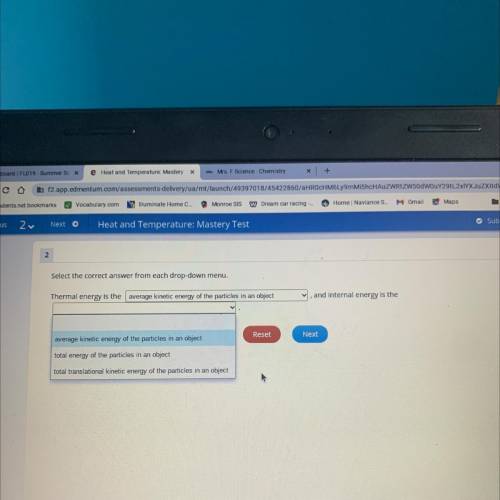Select the correct answer from each drop-down menu.
Thermal energy is the
and internal energy...


Answers: 3
Other questions on the subject: Chemistry

Chemistry, 22.06.2019 07:20, rex1578
Part b: study of equilibrium on solubility: mg(oh)2(s) ⇌ mg2+(aq) + 2 oh–(aq) cloudy clear (pink) 7. a. b. 8. a. b. 9. 10. 11. 12. when adding concentrated hydrochloric acid, how did the appearance of the equilibrium mixture change? the change in appearance indicated a shift in the point of equilibrium. in which direction did the equilibrium shift? (l) left (r) right explain your answer to question 7a. you should indicate which ion was added to or removed from the equilibrium mixture. when adding edta, how did the appearance of the equilibrium mixture change? the change in appearance indicated a shift in the point of equilibrium. in which direction did the equilibrium shift? (l) left (r) right explain your answer to question 8a. you should indicate which ion was added to or removed from the equilibrium mixture. upon heating in which direction is the equilibrium shifting? upon cooling in which direction is the equilibrium shifting? is the forward reaction a. endothermic explain your answers to questions 9, 10, and 11. (l) left (r) right (l) left (r) right b. exothermic
Answers: 1

Chemistry, 22.06.2019 22:00, memeE15
Show transcript transcripts online experiment: atomic structure [the history of atomic theory] this animation will you test rutherford’s hypothesis that it took a great number of shots to actually hit the nucleus because the size of the atom was so much larger than the nucleus.[clipboard and pencil with a diagram of rutherford’s gold foil experiment] we are going to use a cardboard box to represent the atom, a wooden block to represent the nucleus, and marbles to represent the alpha particles. [animated cardboard box, wooden block, and marbles] the box’s measurements are: length = 50 cm, width = 25 cm, and height = 25 cm. the measurements of the block are: length = 10 cm, width = 10 cm, and height is 5 cm. jose and priscilla will conduct the experiment. [animated boy and girl] priscilla put the block in the box on the floor. jose will close his eyes and drop marbles into the box trying to hit the block. priscilla will count the number of times the marbles hit the block and move the block in the box after each hit. [animated block moving inside the box. marble dropping into the box.] here is priscilla’s data of how many times the marble hit the block. out of 100 marble drops or shots, the marble hit the block 32 times. [data table: first column: marble, with rows 1 to 100; column 2: hit, with rows indicating yes or no. last row: total hits] now you can follow the directions in the experiment to present your findings. present your findings when you are finished with the experiment, complete the following data analysis and record your answers in the essay box below. determine the volume of the box and the block. determine the ratio of the block to the box: multiply this number by 100 to turn it into a percent. complete this statement: the volume of the block is percent of the volume of the box. determine the ratio of the number of hits to the number of shots: multiply this number by 100 to turn it into a percent. complete this statement: the block was hit percent of the time. compare the results of step 2 to the results of step 3. are the percentages similar? write a conclusion discussing the following items: based on your findings, do you think rutherford's hypothesis was reasonable? restate rutherford's hypothesis and describe how you tested it. state whether your results support the hypothesis. if they do not, can you suggest some error in experimental procedure (other than general human error) that might explain it? finally, explain how this experiment confirms the nuclear model of the atom and the idea that most of the atom is empty space.
Answers: 1

Chemistry, 22.06.2019 23:50, josie311251
Be sure to answer all parts. the following equilibrium constants were determined at 1123 k: c(s) + co2(g) ⇌ 2co(g) k'p = 1.30 × 1014 co(g) + cl2(g) ⇌ cocl2(g) k''p = 6.00 × 10−3 calculate the equilibrium constant at 1123 k for the reaction: c(s) + co2(g) + 2cl2(g) ⇌ 2cocl2(g) 4.68 × 10 9 (enter your answer in scientific notation.) write the equilibrium constant expression, kp:
Answers: 3

Chemistry, 23.06.2019 00:30, StayPuftMarshadowMan
What would be the original temperature of a gas that has a volume of 2.0 l and a pressure of 2.0 atm and an unknown temperature that the volume increased to 3.5 l in its pressure decreased to 1.0 atm if the final temperature is measured to be 11°c
Answers: 1
Do you know the correct answer?
Questions in other subjects:

Mathematics, 20.01.2021 17:10

History, 20.01.2021 17:10

Arts, 20.01.2021 17:10


Business, 20.01.2021 17:10

Mathematics, 20.01.2021 17:10


Mathematics, 20.01.2021 17:10

Mathematics, 20.01.2021 17:10







